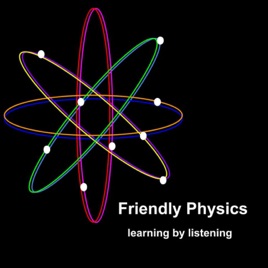
Advertise on podcast: Friendly Physics
Rating
5 from
Country
This podcast has
13 episodes
Language
Publisher
Explicit
No
Date created
2021/06/04
Average duration
11 min.
Release period
13 days
Description
Physics should be simple. It is all around us, relevant in math, biology, sports and space. Let's break it down and listen to ~10 minute episodes on topics ranging from speed to parallel universes. Friendly Physics is produced by a high school physics teacher and steps listeners through kinematics, simple machines, electromagnetism and more.
Podcast episodes
Check latest episodes from Friendly Physics podcast
Forces
2021/10/19
So what is a force?A force is really just a push or a pull on an object. It occurs when two objects interact with each other. Forces can be contact forces, meaning that the objects have to actually touch. Or they can be at a distance, think along the lines of magnets or gravity. A force is still present but the objects are at a distance. It helps most to think about forces in terms of balance. You might hear the terms balanced or unbalanced forces. Just as with velocity, we split forces into dimensions. So we talk about vertical forces and horizontal forces. Forces that act in the vertical dimension and forces that act in the horizontal dimension. When balanced forces act on an object, that object does not move. Imagine tug of war where both teams are pulling completely equally. The force to the left is the same as the force to the right. They cancel each other out. They’re balanced. Unbalanced forces are forces that act on an object unequally. Imagine one tug of war team pulling with 70 N of force and the other team pulling with 40 N of force. They are unequal. They are unbalanced forces. The team pulling with more force will move the other team.
more
Newton's Laws
2021/09/28
Let’s forget the math today and focus on Newton’s Laws.Newton was a mathematician and physicist born in the 1600s. He existed, taught and studied well before many of our modern discoveries had been made, but his impacts are still felt today. Most importantly, for us, in this Laws of Motion.There are 3 Laws of Motion. All have to do with force and how an object experiences force. The First Law is commonly referred to as the Law of Inertia. This law states that an object at rest stays at rest unless acted upon by an outside force. An object in motion stays in motion unless acted upon by an outside force. There are a few ways to interpret this → most simply, objects do not just spontaneously start moving. A force MUST be applied to them. If you ever see a ball start to roll, a book start to fall or a flag wave in the wind, it is because a force was applied. Similarly, object do not just spontaneously stop moving. A ball will roll and roll across the ground until … it hits a wall. Or until … the force of friction slows it down. Db Link:https://bit.ly/37cP8YP
more
Projectile Motion - Part 2
2021/09/20
However, we don’t always just move objects at a parallel to the ground. More often than not, we move them at an angle. Think about your field goal kickers on a football field or a missile being launched. These objects move up, peak and then come down.We say that they follow a trajectory. They exhibit parabolic motion. The objects peak and then they fall. They are projectiles.There are many important things about this motion. First, lets focus on that angled launch. Remember how last time we had to pay careful attention to the phrasing of the problem? Was the initial velocity horizontal or vertical?Last week we talked about initial horizontal velocity. Objects launched parallel to the ground. But this week the launch is at an angle and so the velocity can be split into horizontal and vertical components.This is where geometry and trigonometry comes into play. Let’s imagine that a football is kicked at a 30 degree angle from the ground with an initial velocity of 28 m/s.The initial velocity is 28 m/s at a 30 degree angle. Velocity is a vector. Direction matters and therefore we are able to split the velocity into horizontal and vertical components.
more
Projectile Motion - Part 1
2021/08/18
I promised an exciting episode that would take us into a whole new dimension.Let’s start talking projectile motion → the movement of objects that break beyond just one dimension and instead travel both horizontally and vertically.We are going to discuss objects that move down and sideways today. It is the easiest way to begin talking about projectiles. Imagine a cannon on the top of a cliff, shooting a cannon ball out. The ball travels horizontally out of the cannon, but eventually starts to fall down. Why?Gravity. Projectile motion shows that even when an object moves horizontally through the air, it is still subject to gravity pulling it down. Think of a paper airplane tossed out into the air. Or a pitcher throwing towards home plate. While we talk today, it’s important to imagine objects that are moving in a straight line horizontally and then falling. Don’t toss the paper airplane up and then watch it come down. Throw the paper airplane parallel to the ground and then see it glide down. The cannon ball is shot out of a completely horizontal cannon, not up at an angle.
more
Launching Upward
2021/07/29
An important thing to keep in mind as we discuss upward vertical motion → we are talking about objects launching straight up into the air. Ideally, without wind or disproportionate weight or any other factors, an object launched upward from the ground would move in a straight line. That is the type of motion we are dealing with here.Two weeks ago we added an element to our motion repertoire: vertical motion.We started talking about motion in terms of falling - it just seemed easier to start with falling since we are all familiar with gravityWe took a little detour last week to talk more in depth about the kinematic formulas - what each variable means and where they came from.When an object falls there are a few things to keep in mind -When an object hits the ground, we say that its final position (Yf) is zero.Objects that fall always have an initial velocity of 0 m/s because they are still in the instant before they fall.Finally, we always replace the a in our kinematic formulas with -9.8 m/s2. A negative because gravity pulls objects DOWN and we have set the standard that up is positive and down is negative.When we talk about an object that is moving up, things are not all that different.Remember a when we talked about the stomp rocket - you step on the launch pad and up they go.EarlyBird Link:https://partners.getearlybird.io/podcast
more
The Kinematic Formulas
2021/07/22
Last week we listened to the start of a new idea. We expanded on motion and are now talking about up and down → vertical motion.We spent a lot of time getting accustomed to objects moving - where they are, how fast they move, what direction that movement is inAnd now we’re applying it to objects that are withstanding the force of gravity.Last week I gave you two equations → the first one was simple. It says v is equal to Vo (initial velocity) + a times t. (acceleration times time)The other formula was a little more complicated.The formula says position equals initial position + initial velocity times time plus ½ acceleration times time squaredY = Yo + vo t + ½ a t^2To truly use these formulas and to do so successfully, is to understand vertical motion.Vertical motion is an object moving up or down. I want you to imagine an apple falling from a tree when we are talking about an object falling down. I want you to imagine one of those stomp rockets where you set a little foam rocket on a launcher, attached to a pump that you step on and then the rocket goes up when you stomp. Imagine that rocket when we are talking about an object launching up.
more
Free Fall
2021/07/14
We are going to spend the next episodes talking about TWO dimensional motion. UP & left, down & right. We are adding a whole new dimension to motionBefore we do that,We are going to check off one more type of one dimensional motion → vertical motion. Motion that is UP or DOWN.When we start to talk about vertical motion we have to worry about gravity.If you throw a ball up into the air, what happens? It goes up and up, but eventually it comes back down.Link: https://hellofresh-ca.o5kg.net/c/2544961/791027/7893Code: HFAFF80Offer: $80 Discount ($50 - $20 - $10) Including Free Shipping on First Box!
more
Graphing Position, Velocity & Acceleration
2021/07/07
We are wrapping up one dimensional motion today with all of the key ideas covered. We’ve talked about distance and displacement, speed and velocity and last week we talked about acceleration as the rate of change of the velocity over time.We talked about how positive acceleration means the velocity is increasing, the object is speeding up, and negative acceleration means the velocity is decreasing, the object is slowing down.And then, I left you with a few challenge questions... I asked you to imagine a runner on a track, starting at the starting line and picking up speed at a constant acceleration. That meant that the runner had a positive velocity → because they were moving away from their initial position and a positive acceleration because their velocity was increasing.Often times, we will see position, velocity and acceleration tracked graphically in physics.If you can master the skill of graphing, it makes understanding these relationships even easier. Feel free to pull up a graph right now if it will be easier for you to visualize this.Time will always be on the x axis side to side and the y axis up and down will either be position, velocity or acceleration.
more
Acceleration
2021/06/30
Let’s get to it.Acceleration is the rate of change of an object's velocity. It is how the velocity changes. When car companies brag about how quickly their vehicles go from 0 to 60, they are talking about the acceleration.They are talking about how quickly their car's velocity can change from 0 mph to 60 mph.Objects don’t just stay at a constant velocity, always moving at 2 m/s. They speed up and slow down. That change from 2 m/s to 10 m/s as an object speeds up or from 2 m/s to 1 m/s as the object slows down, is the acceleration.We can make a connection here.We talked about velocity as change in position over time.Acceleration is the change in velocity over time.
more
Speed vs Velocity
2021/06/16
How do we discuss HOW FAST an object moves?Let’s start with speed:SPEED is the rate at which an object covers ground.If you’re a math head like me:SPEED is distance divided by time , the distance an object travels in a unit of time.If you are driving 70 mph → you can cover 70 miles in one hour . . . if you are going at a constant speed.
more
Scalars vs Vectors
2021/06/09
If you didnt listen to my last episode on Distance vs Displacement - give that one a listen for a little bit of context on how we talk about movement. In the last episode we determined that there are two different ways to talk about how much an object moves - distance or displacement.Distance is the total ground covered by an object and displacement is the difference between an objects FINAL and INITIAL position. These are going to be important definitions to keep in mind as we continue discussing movement. Most importantly, we talked about DIRECTION. When stating a displacement, it is important to specify what direction that object was displaced in. Now that we’ve got that refresher: Let’s move on to two TYPES of measurements that you will see in physics.
more
Distance vs Displacement
2021/06/02
Let's start off by discussing the idea of movement.What is movement?How can someone move?Do we care about direction?Do we care how fast someone is going?If we really want to start off with the basics, then lets answer this question today:How much does an object move?We have 2 different ways to answer this question and that is where distance vs displacement comes into play.
more
Podcast sponsorship advertising
Start advertising on Friendly Physics & sponsor relevant audience podcasts
You may also like these physics Podcasts

5
26
21
Nuclear Waste: The Whole Story
Deep Isolation

0
0
11
4 A.M. Thots
Tree Soelberg

5
6
6
Atomic Interviews
Luke Tower

5
16
41
3:12 - The HRP Podcast
HRP Associates Inc.

0
0
36
More than Abstract
More than Abstract

0
0
40
Podcasts de Física
fisicapodcasts

4.9
34
24
Oddly normal
Van Nguyen

0
0
1
Nora Batugal
NORA BATUGAL

0
0
193
CosmoTeo
Alexandre Fernandes

0
0
1
THEOARMI
Arjit Mishra



